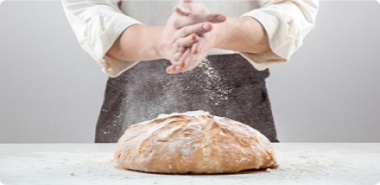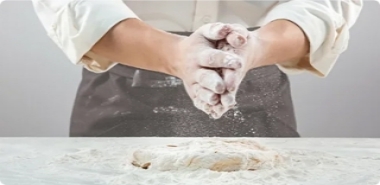Abstract:In recent years, with the development of economy, the food industry has developed rapidly. The market has higher and higher requirements for the quality of ice cream. How to improve the quality and taste of ice cream at a low cost is one of the main concerns of ice cream manufacturers. Monoglycerides have a very significant impact on the quality of ice cream. Molecularly distilled monoglyceride has become an indispensable ingredient in ice cream ingredients. This paper introduces the application of molecularly distilled monoglyceride in ice cream in detail, in order to provide reference for the production of ice cream.
Keywords: food ingredient Distilled Monoglycerides ice cream
Monoglyceride is an efficient food emulsifier and surfactant, which can play the role of emulsification, foaming, dispersing and defoaming, and anti-starch aging. It is widely used in various food fields and is the most widely used emulsifier in food. . Europe and the United States applied them to the food industry in the 1930s. In the 1960s, molecular distillation technology began to be applied to the separation and purification of monoglycerides. In the 1980s, Guangzhou Institute of Light Industry (predecessor of Meizhan Group Additives Company) took the lead in researching the molecular distillation process of monoglycerides. In the 1990s, industrial production has been realized, and the annual output has reached thousands of tons.
1.The effect of monoglycerides on the quality of ice cream
The monoglyceride substituted part of the complex protein was adsorbed on the surface of the fat globules, which had a significant impact on the ice cream quality. In the production process, the influence of monoglyceride is mainly reflected in the following points: improving the dispersibility of fat in the mixture, making the fat particles fine and evenly distributed, and improving the stability of the emulsion; promoting the interaction between fat and protein, making the Emulsion destabilization or demulsification helps to control the agglomeration and cohesion of fat; control the formation of coarse ice crystals, giving ice cream a fine structure and good dryness; improve stability and shape retention; prevent ice cream from storing During the process, it shrinks and deforms to improve mouth melting.
 2.The role of monoglycerides in mixing and homogenization
2.The role of monoglycerides in mixing and homogenization
In the ingredients of ice cream, if all the fat comes from milk fat, there is no need to add an emulsifier to stabilize the emulsion. This is because the fat in the dairy product itself exists in an emulsified form, and the surface of the fat is covered by casein. It can be well dispersed in aqueous solution to form emulsion. If other non-dairy fats are added to the ingredients, part of the monoglyceride needs to be added to stabilize the fats to form a homogeneous emulsion to prevent material stratification from affecting subsequent operations.
During the homogenization process, a variety of lipoproteins are formed from monoglycerides, fats and proteins, which stabilize the protective film of fats and have certain functional properties in ice cream mixes.
2.1.The role of monoglycerides in aging
During the aging process, the materials of ice cream undergo various physical and chemical changes, mainly including the hydration of milk protein, the complete hydration of stabilizers, the crystallization of liquid fat and the analysis of protein. Among these physical and chemical changes, the influence of monoglyceride is relatively Large ones have liquid lipids to prevent crystallization and protein desorption.
2.1.1.The effect of monoglycerides on liquid fat crystallization
During aging, the fat is prevented from crystallizing due to the lower temperature. During crystallization, the fat at different melting temperatures segregates in the ice cream mix, and the higher melting point triglyceride crystallizes first, and is oriented on the surface of the fat globules to act as crystals. The role of the nucleus makes the low-melting fat anti-crystallizing liquid more or less retained in the core according to the composition of the fat, so the fat-anti-particles have a certain plasticity, and the material is subjected to strong mechanical action during the freezing process. , The solid crystal will be scraped, and the liquid fat wrapped in it will be squeezed out. The extruded liquid fat can form a protective layer on the surface of the air bubbles that are stirred in, which helps to improve the expansion rate, and the interaction between the liquid fat, Together with the protein, the broken solid fat is connected to form the skeleton of the ice cream, so the crystallization of the liquid fat during the aging process has an important influence on the quality of the ice cream.
The crystallization of liquid fat is mainly affected by the type of fat, while monoglycan can also affect the crystallization of fat.
2.1.2.The effect of monoglycerides on protein desorption
Casein and whey protein are adsorbed on the surface of fat globules to stabilize the fat globules, but in the production process of ice cream, if the milk protein is too stably adsorbed on the surface of the fat globules, it will not be conducive to the overflow and agglomeration of fat, thus affecting the skeleton of the ice cream. Therefore, the proper desorption of protein in the aging process of ice cream material will help to improve the quality of ice cream, and the addition of monoglyceride will promote the desorption of protein. It is stronger than protein. When interacting, monoglyceride has a greater effect on lipids, so monoglycerides can promote the desorption of proteins, so that lipids can seep out from the thinned membrane.
2.2.The role of single sweetener in freezing
After aging, the ice cream material begins to freeze. During this process, the viscosity of the ice cream material rises, and part of the water turns into ice crystals. At the same time, air is gradually mixed in to make the ice cream expand. In this process, the fat globule can be destabilized. , to promote the extrusion of liquid fat during the whipping process. At the same time, since the changes of the material in this process are based on the aging process, the effect of monoglycerides in this process can be directly reflected by the quality of the final ice cream. come out.
3.Conclusion
From the above analysis, it can be seen that monoglyceride has an important influence on the quality of ice cream, but the addition amount is not the better. It is conceivable that if too much monoglyceride is added, the casein will be completely desorbed during the aging process. The solid fat content is also particularly high, so the broken solid fat during the freezing process cannot form a good skeleton due to the lack of liquid fat. At the same time, the air bubbles stirred in due to the lack of protection of the liquid fat will cause the expansion rate to decrease and the taste to be greasy. In the actual production process, it is necessary to control the amount of single sweetener, and the compound effect of various emulsifiers is better. It takes many tests to get better quality ice cream.
For more information, welcome to bookmark our website: https://www.cnchemsino.com/
Contact us for price and details : info@cnchemsino.com 








